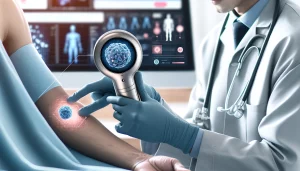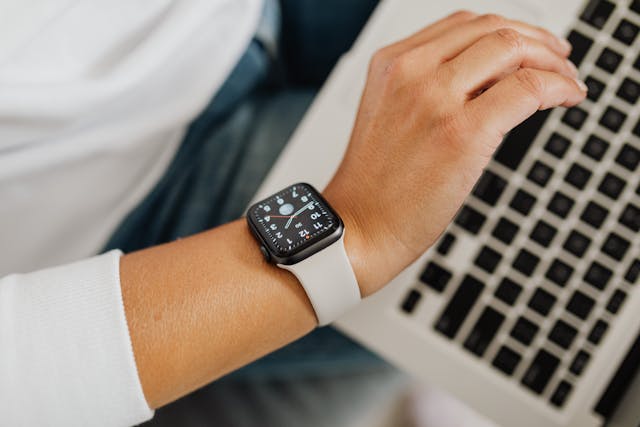Wearable technology is no longer a futuristic concept; it is deeply embedded in our daily lives. These innovations range from smartwatches to advanced smart fabrics, offering insights into our health and helping us interact with the digital world. Innovations in next-gen materials, smart contact lenses, e-tattoos, and flexible electronics have transformed the scope of wearables. The global wearable technology market was valued at over $55 billion in 2022, with projections estimating it will exceed $142 billion by 2030. This growth trajectory emphasizes the increasing importance of wearable devices in enhancing health and fitness, as well as reshaping human-machine interactions.
Wearables have evolved from simple fitness trackers to devices capable of real-time health monitoring, smart energy management, and even remote medical care. The next frontier involves devices like smart contact lenses, e-tattoos, and bio-integrated electronics that offer seamless integration with the human body.
1. The Rise of Wearable Technology

The rapid rise of wearable technology began with the development of fitness trackers and smartwatches, offering people the ability to monitor their activity, heart rate, and sleep patterns. However, the capabilities of wearables have expanded well beyond fitness, now incorporating advanced health monitoring, human-machine interaction, and medical diagnostics.
The first wearable devices were relatively simple, often limited by battery life and basic data collection. Today’s devices are far more sophisticated, integrating advanced sensors, AI, and machine learning algorithms to provide real-time feedback. Wearables are now used for monitoring chronic diseases, offering real-time diagnostics, and enhancing productivity by merging digital and physical environments.
2. Innovations in Next-Gen Materials for Wearables
The materials used in wearable devices have progressed significantly over time. Next-gen materials, such as bioresorbable electronics, liquid metal-polymer conductors (MPCs), and 2D materials, are leading this innovation. These materials are designed to be flexible, biocompatible, and conducive to seamless integration with human tissues.
Key Innovations:
- Bioresorbable Electronics: These devices dissolve in the body after fulfilling their intended function, eliminating the need for surgical removal. Bioresorbable devices are particularly useful for temporary health monitoring or therapeutic applications, such as post-surgical care or controlled drug release.
- Liquid Metal-Polymer Conductors (MPCs): Gallium-based liquid metals combined with polymers are paving the way for conformal bioelectronics that adhere to the skin. This innovation allows for real-time physiological monitoring without discomfort, making it easier for users to wear such devices for extended periods.
The development of 2D materials, such as graphene, also opens the door to highly flexible electronics. These materials are lightweight and can be incorporated into various surfaces, enabling the creation of stretchable and bendable wearable devices.
3. Smart Contact Lenses: A New Frontier in Eye Care
One of the most exciting advancements in wearable technology is smart contact lenses, which combine sensors and wireless communication technologies to monitor eye health and track biomarkers. These lenses are designed to provide real-time information on a range of conditions, including glaucoma, diabetes, and even neurological diseases.
Benefits of Smart Contact Lenses:
- Continuous Monitoring: Unlike traditional diagnostic tools, smart lenses offer continuous and non-invasive monitoring of various health indicators, providing patients with an effortless experience.
- Early Disease Detection: By analyzing tear composition or monitoring intraocular pressure, smart contact lenses can detect the early stages of diseases like glaucoma or diabetes. This ability to provide early warnings can improve treatment outcomes and reduce complications.
Example:
In a collaboration between Google and Novartis, a prototype smart lens was developed to measure glucose levels in diabetic patients through their tears. This eliminates the need for painful finger-prick tests and enables real-time, non-invasive monitoring.
Despite their potential, smart contact lenses face challenges, such as gaining user acceptance, manufacturing scalability, and ensuring the security of the collected data.
4. E-Tattoos: Revolutionizing Skin-Based Health Monitoring

E-tattoos represent the next leap in wearable health monitoring. These ultrathin, skin-like devices provide continuous monitoring without impeding user comfort. They adhere directly to the skin, becoming almost imperceptible while gathering crucial data on physiological and psychological conditions.
Applications of E-Tattoos:
- Vital Signs Monitoring: E-tattoos can track vital signs such as heart rate, body temperature, and electrical activity, providing crucial data for remote patient care and disease management.
- Telemedicine: In the age of telemedicine, e-tattoos offer a promising solution for remote diagnostics, allowing healthcare providers to monitor patients without the need for hospital visits.
Example:
Researchers at the University of Texas have developed e-tattoos that can continuously monitor electrocardiogram (ECG) data, allowing healthcare providers to gain real-time insights into a patient’s heart health.
As e-tattoos continue to evolve, they promise to revolutionize areas such as telemedicine, mobile health, and human-machine interaction.
5. The Role of Flexible Electronics in Wearables
Flexible electronics form the backbone of modern wearable technology. These devices leverage 2D materials and advanced fabrication techniques to create electronics that can bend, stretch, and flex with the human body. This adaptability makes them ideal for creating comfortable and durable wearables.
Key Applications:
- Wearable Sensors: Flexible electronics are used to create sensors capable of monitoring body temperature, heart rate, and even sweat composition, enabling non-invasive and real-time health monitoring.
- Energy Harvesting: Some flexible electronics are capable of harvesting energy from the wearer’s movements, which allows wearables to function without traditional batteries.
Example:
Researchers have developed flexible sweat sensors that continuously monitor hydration levels. These devices can be worn during exercise and provide valuable insights into an athlete’s hydration status, helping them avoid dehydration and perform optimally.
The lightweight and scalable nature of flexible electronics make them ideal for a wide range of applications, including healthcare, entertainment, and even military uses.
6. Benefits of Wearable Technology in Healthcare and Beyond
Wearable technology offers significant benefits in healthcare, fitness, and other industries. Devices like smartwatches, smart garments, and e-tattoos provide unprecedented insights into personal health and help people optimize their fitness. Additionally, wearables enhance safety by enabling remote monitoring of patients with chronic illnesses.
| Benefit | Wearable Device | Description |
|---|---|---|
| Real-Time Health Data | Smartwatches, E-tattoos | Track vital signs in real-time, helping individuals manage their health more effectively. |
| Fitness Insights | Fitness Trackers, Smart Garments | Analyze physical activity, sleep patterns, and more to motivate users to maintain fitness. |
| Remote Monitoring | Smart Contact Lenses, E-tattoos | Monitor chronic diseases from afar, reducing the need for frequent hospital visits. |
| Human-Machine Interaction | Haptic Interfaces | Provide seamless control over virtual environments, enhancing the user experience. |
| Energy Efficiency | Flexible Electronics | Devices powered by kinetic energy reduce dependency on traditional power sources. |
7. Comparative Analysis of Wearable Devices
To understand the diverse range of wearable devices available, a comparative analysis can highlight the unique advantages and limitations of each technology.
| Technology | Use Cases | Advantages | Challenges |
|---|---|---|---|
| Smart Contact Lenses | Eye health monitoring, disease tracking | Non-invasive, continuous health tracking | High costs, complex integration with healthcare systems |
| E-Tattoos | Health monitoring, wound healing | Comfortable, versatile, and near-invisible | Limited battery life, scalability issues |
| Flexible Electronics | Sensors, energy harvesting | Stretchable, energy-efficient | Manufacturing challenges, durability concerns |
| Smartwatches | Fitness tracking, health monitoring | User-friendly, widely adopted | Short battery life, accuracy limitations |
| Haptic Interfaces | Human-machine interaction | Enhanced tactile feedback for immersive experiences | Requires advanced tech infrastructure |
8. The Challenges Facing Wearable Technology
Despite the immense potential of wearable technology, several challenges remain. Battery life continues to be a major limitation, as many devices require frequent charging. In addition, concerns around data privacy are growing, as wearables collect sensitive personal data, including health metrics.
Key Challenges:
- Battery Life: Extending battery life or developing energy-harvesting wearables is crucial for long-term, continuous usage.
- Data Privacy: Wearables collect vast amounts of personal data, raising concerns about who has access and how it is used. Stricter regulations and data encryption protocols are necessary to ensure user safety.
- User Acceptance: For wearables to become mainstream, users need to accept the technology. Comfort, design, and perceived usefulness play critical roles in adoption.
9. Future Trends in Wearable Technology

As technology continues to advance, the future of wearable technology is promising. Here are a few trends expected to shape the future landscape:
Key Trends:
- Integration with AI and Machine Learning: Future wearables will increasingly use AI to analyze data, making personalized health recommendations based on individual patterns and behaviors.
- Biometric Authentication: Wearables will likely incorporate biometric authentication to improve security, enabling features like contactless payments through fingerprint or facial recognition.
- Sustainable Materials: As the world becomes more environmentally conscious, expect a shift toward sustainable and recyclable materials in wearable tech.
- Expanded Healthcare Applications: More advanced wearables will emerge, capable of monitoring a broader array of health metrics, potentially serving as comprehensive health monitoring systems.
10. Conclusion:
Wearable technology continues to evolve, offering exciting opportunities for improving healthcare, enhancing fitness, and enabling more intuitive human-machine interactions. While challenges remain, particularly in terms of energy efficiency, scalability, and data privacy, the future of wearables looks bright.
As next-gen materials, smart contact lenses, e-tattoos, and flexible electronics become more advanced, wearable devices will become increasingly integrated into our daily lives, revolutionizing healthcare and providing new ways to interact with technology. With the right investments in research, development, and regulatory frameworks, the potential of wearable technology is limitless, promising a healthier, more connected future for all.












